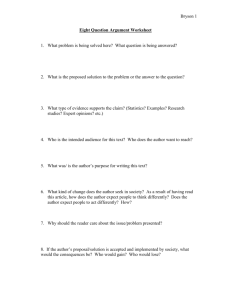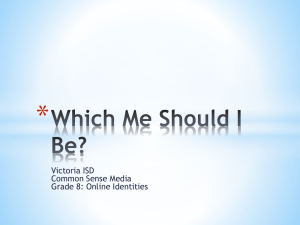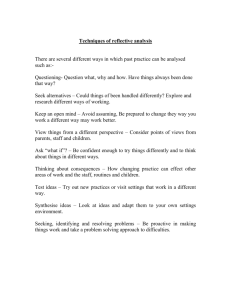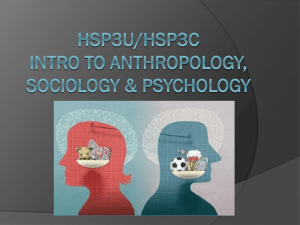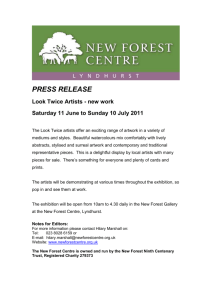File
advertisement
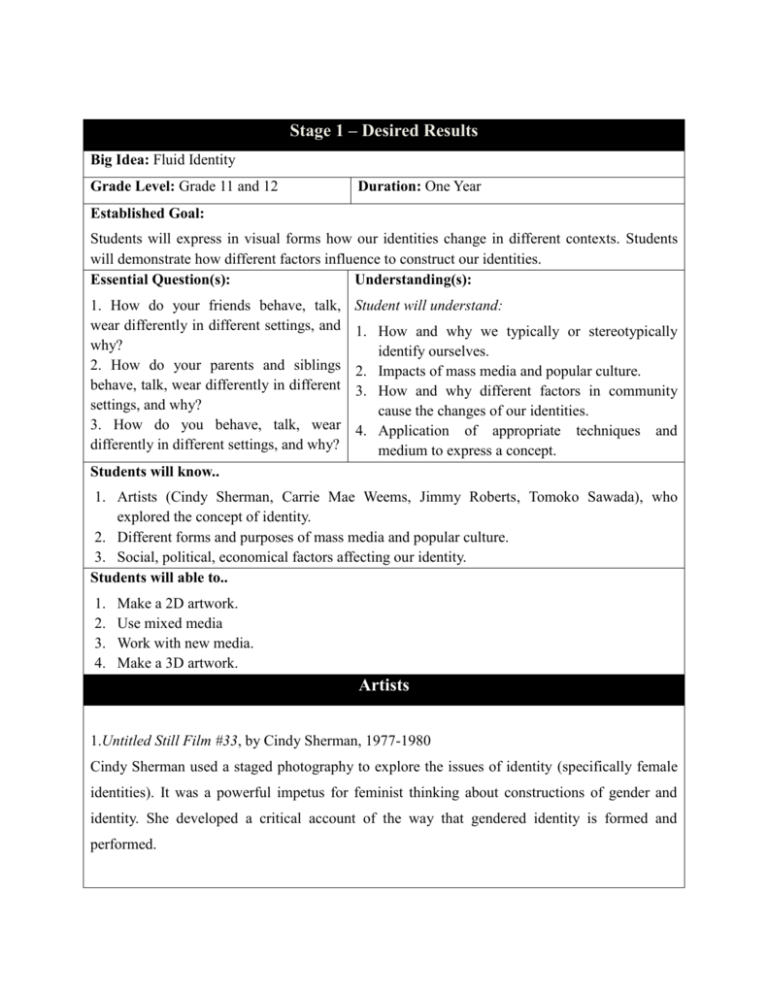
Stage 1 – Desired Results Big Idea: Fluid Identity Grade Level: Grade 11 and 12 Duration: One Year Established Goal: Students will express in visual forms how our identities change in different contexts. Students will demonstrate how different factors influence to construct our identities. Essential Question(s): Understanding(s): 1. How do your friends behave, talk, wear differently in different settings, and why? 2. How do your parents and siblings behave, talk, wear differently in different settings, and why? 3. How do you behave, talk, wear differently in different settings, and why? Student will understand: 1. How and why we typically or stereotypically identify ourselves. 2. Impacts of mass media and popular culture. 3. How and why different factors in community cause the changes of our identities. 4. Application of appropriate techniques and medium to express a concept. Students will know.. 1. Artists (Cindy Sherman, Carrie Mae Weems, Jimmy Roberts, Tomoko Sawada), who explored the concept of identity. 2. Different forms and purposes of mass media and popular culture. 3. Social, political, economical factors affecting our identity. Students will able to.. 1. 2. 3. 4. Make a 2D artwork. Use mixed media Work with new media. Make a 3D artwork. Artists 1.Untitled Still Film #33, by Cindy Sherman, 1977-1980 Cindy Sherman used a staged photography to explore the issues of identity (specifically female identities). It was a powerful impetus for feminist thinking about constructions of gender and identity. She developed a critical account of the way that gendered identity is formed and performed. Sally Song ILang, Curriculum Development 2 2. Kitchen table series, by Carrie Mae Weem Carrie Mae Weem challenged the fixed categorization of a woman’s identity. She expanded the perspective of her work from the personal (her family experiences) and the political (racism) to broader issues of gender relations, individual identity and parenting. “The Kitchen Table Series” is a photographic investigation of a single domestic space in which the artist staged scenes of “the battle around the family.” 3.Untitled, by Jimmy Roberts. Jimmy Robert explored the idea that one’s identity changes depending on the viewers. He used print-making and collages. 4.Tomoko Sawada Sally Song ILang, Curriculum Development 3 Tomoko Sawada is Japanese artist, who studied her cultural identity and youth identity as Japanese student. She disguises herself to portray different roles traditionally assigned to the female gender in Japan and questions societal norms and culture. Stage 2 – Assessment Evidence Performance Task (s): Other Evidence: A final artwork (in any art media), expressing “the fluidity of identity”; explore how our identities change in different contexts, and how different factors influence us to construct our identities. 1. An art journal 2. A final artist’s statement (written work 100-150 words) 3. A self reflection on the finished work (written work 100-150 words) 4. A class art exhibition. (Participating and cooperating in organizing and planning process) 5. Finished final artwork Assessment Criteria: 1. Did you complete the final artwork? 2. Does your work reveal the evidence of the fluidity of identity? (eg. Changes (or transformation or differences) of behaviors, ways of speech and fashion in different settings, influencing factors such as popular culture, people (family, friends, teachers..etc) and different locations (schools, home, churches, streets..etc) or any other social/economic or political factors that you have found from news papers or magazines or that you observed from your parents.) 3. Is your choice of art media effective to deliver your concept? 4. Are the techniques and skills of a chosen art media professionally applied? 5. Does your artist’s statement clearly present a deeper understanding of the concept and the art medium you explored? 6. Does your self-reflection clearly show what you have learned from this project? 7. Did you actively participate and contribute in a class art exhibition? Sally Song ILang, Curriculum Development 4 8. Did you submit your art journal that reflects the development of your ideas, the research on artists, the understanding of mass media and pop culture and personal thoughts and notes on your identity, sketches and planning of the final artwork? Stage 3 – “Possible” Learning Activities *Learning Activities can be flexible depending on students’ needs. *These learning activities are not in any form of orders. Learning Topic: Concept of identity in art world. Learning Task: Students will learn how different artists explore the concept of identity differently. They will research Cindy Sherman, Carrie Mae Weems and Jimmy Roberts. Students will compare and contrast their techniques and how they approach the concept of identity. Learning Evidence: Students will keep art journals recording their researches, for example, they will write a response to or analyze artists’ works. They will show attempt to learn the techniques used by different artists. Learning Topic: Learning techniques and skills Learning Task: After students learn about the different artists’ technical and conceptual approaches to identity, they will choose one favorite artist from four artists (Cindy Sherman, Carrie Mae Weems, Jimmy Roberts and Tomoko Sawada) and try to make an artwork using her/his style. The ideas do not necessarily have to be ‘identity’. This learning task is purely focused on experimenting techniques and skills. Learning Evidence: Students will produce an artwork in styles of their favorite artists. Learning Topic: How do your friends behave, talk, wear differently in different settings, and why? Learning Task: Students will learn how their friends behave, talk and wear differently in different settings such as in school, at home, at church and in different situations with different types of people. They will observe and have conversation about each other. They will identify different factors influencing their behaviors, talking habits and fashion, for example, mass media and popular culture. Learning Evidence: Students will write a response in the art journals to explain the observation of their friends and identify different factors, which caused different behaviors, talking habits and fashion. Students will also find several examples of mass media and popular culture, which influenced their friends. They will create 2D mixed media art works to demonstrate the studies of their friends. Learning Topic: Sally Song ILang, Curriculum Development 5 Stereotypes in our society Learning Task: Students will learn about the stereotypes that are used to identify ourselves. Learning Evidence: Students will find some examples of the stereotypes from mass media: for example, literatures, templates, brochures, magazines, newspapers, advertisements, movies, television, videogames and animations. They will create a collage of their findings using graphic software program (for example, Photoshop, illustrator and In-Design). Learning Topic: How do your parents and siblings behave, talk, wear differently in different settings, and why? Learning Task: Through observation and interviews, students will learn how their family members behave, talk and wear differently in different settings such as at workplace, at home, in public places and in different situations with different types of people. They will identify different factors influencing their behaviors, talking habits and fashion, for example, social, political or economical factors. Learning Evidence: Students will video and record the observation of their family members every day. Learning Topic: How do you behave, talk, wear differently in different settings, and why? Learning Task: Students will be introduced to “Fluid Identity”, and there will be a class discussion. 1. What does identity mean? 2. What does ‘fluid’ mean? 3. What does ‘change’ mean? 4. What does it mean by having ‘fluid identity’? 5. Why is ‘fluid identity’ relevant to us in 21st century? Based on the previous learning activities, students will brainstorm the factors that influence their behaviors, talking habits and fashion. 1. How do you typically identify yourself? 2. How do you behave/talk/wear differently in different settings? 3. How do you behave/talk/wear differently with different people? 4. What are the possible factors that influence you? Learning Evidence: This activity will lead to a final task. What is “Fluid Identity”? Sally Song ILang, Curriculum Development 6 1. It is a postmodern idea. 2. It defines “one’s self depend on the audiences without affecting the ‘true’ meaning of self” - Bradatan. C 3. A fluid identity emerges because society is socially less rigid, that individuals have become less class-defined and human relationships are not restricted by accident of birth, but the combination of breaking class distinction through education, income and mind expanding influence of modern travel and entertainment which broadens preordained identities and choices. - Yeoman. I. 4. Environmental determinism theory - Different environment (for example, different climate, different geography) will affect one’s habits of life.

